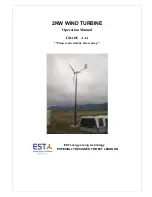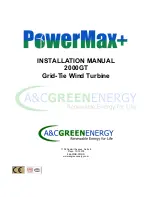
1. Application
A wind power generator is a piece of equipment that converts wind energy into electric power
which is used to charge a storage battery group. It can be widely used in windy areas without
electrical grid access. It is capable of providing power for lighting, TV, telecommunication
equipment and other equipment.
2. Structure and Main performance
The unit is mainly composed of wind rotor, permanent magnet generator, tail vane, stand,
electronic controller, storage batteries, electric inverter, electric cable, and diversion load
(Fig1)
Main technical performances
Rotor Diameter (m)
3.2
Material and number of the blades
Reinforced fiberglass *3
Rated power/maximum power
2000/3000
Rated wind speed (m/s)
10
Startup wind speed (m/s)
3
Working wind speed (m/s)
3
–30
Survived wind speed
40
Working voltage
DC48v
Generator style
Three phase, permanent magnet
Charging method
Constant voltage current saving
Speed regulation method
Electromagnetic brake
Stop method
Manual brake
Tower height (m)
6
Weight (kg)(not including batteries
or inverter)
Main unit 95 / Total 155
3. Preparation
3.1 Prepare batteries according to manufacturers specifications.
3.2 Unpack and check the turbine parts and verify all parts are included.
3.3 Choose
an open and flat place with no barriers around for wind turbine installation.
To avoid losses due to voltage drop over the cable run, the distance between wind turbine
and batteries should be made as short as possible. For best results, it should be less than
30m.
3.4 Install Foundation pylon and anchor points.
3.41 Dig a hole where you want the center pylon for the turbine base. The size of the pylon
should be 50X30X36cm. Next dig four triangular (each side is 80cm) pits with the depth of
60cm symmetrical 4.5 meters from the central hole in four directions. One point of each













